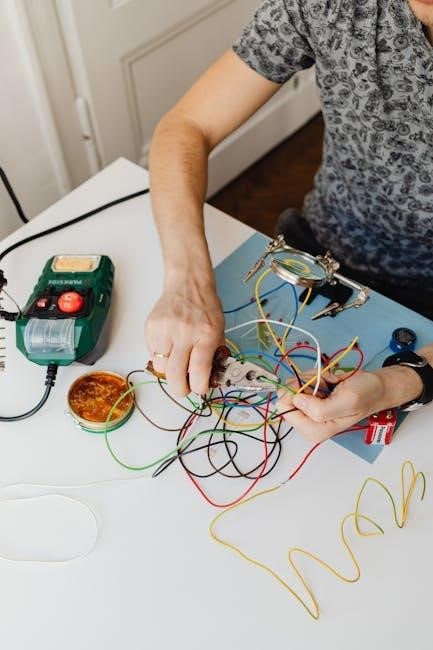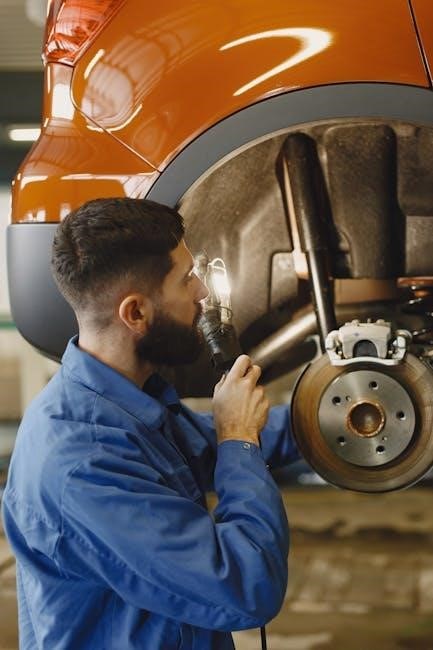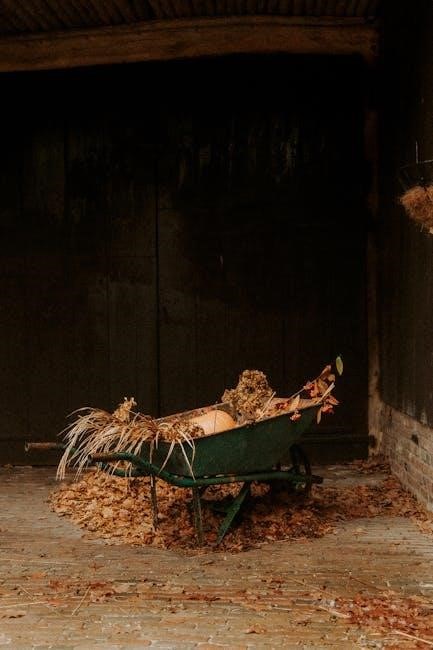Lennox Troubleshooting Manual: A Comprehensive Guide
Facing issues with your Lennox HVAC system? This comprehensive guide provides expert troubleshooting steps for common problems, from ignition failures to blower motor malfunctions. Discover solutions and maintain system performance.
Lennox HVAC systems are renowned for providing efficient and reliable heating and cooling solutions for residential and commercial spaces. These systems incorporate advanced technology and are designed for optimal performance and energy savings. Understanding the basics of your Lennox furnace or air conditioner is crucial for effective troubleshooting. Familiarize yourself with the components, functionality, and maintenance requirements to identify potential issues early on. Proper care and regular inspections can prevent major problems and extend the lifespan of your Lennox system. This guide will help you navigate common issues, understand error codes, and perform basic troubleshooting steps. When in doubt, always consult a qualified Lennox technician.
Common Lennox Furnace Problems
Lennox furnaces, while reliable, can experience issues like no heat, ignition failures, or blower motor malfunctions. Understanding these common problems is the first step toward effective troubleshooting and repair.
Furnace Not Heating or Blowing Hot Air
A furnace failing to produce heat or blowing cold air is a frequent concern for Lennox furnace owners. This issue can stem from various underlying causes that require systematic investigation. Begin by confirming that the thermostat is correctly set to “heat” and the desired temperature is higher than the room temperature. Next, verify the power supply to the furnace, checking for tripped circuit breakers or blown fuses.
A common culprit is a faulty pilot light or ignition system, preventing the burner from igniting the gas. Furthermore, inspect the gas valve to ensure it’s open and functioning correctly. Airflow restrictions, caused by clogged air filters or blocked vents, can also hinder heat distribution. If these preliminary checks don’t resolve the problem, further diagnosis may be needed;
Ignition Failures
Ignition failures in a Lennox furnace prevent the unit from starting, leaving you without heat. Several components within the ignition system can cause this issue. A common cause is a faulty pilot light, which may be dirty, improperly adjusted, or completely extinguished. In modern furnaces with electronic ignition, the igniter itself might be defective.
This component glows to ignite the gas, and if it fails, the furnace won’t start. Another potential problem is a malfunctioning flame sensor. This sensor detects the presence of a flame and allows the gas valve to remain open. If the flame sensor is dirty or faulty, it may incorrectly signal that there’s no flame, causing the furnace to shut down. Addressing ignition failures promptly is essential for restoring heat. It may involve cleaning, adjusting, or replacing faulty parts to restore the furnace’s ignition process.
Blower Motor Malfunctions
A malfunctioning blower motor in a Lennox furnace can manifest in various ways, impacting the system’s ability to circulate air. A common symptom is inconsistent airflow, where the furnace blows weakly or not at all. This can lead to uneven heating throughout the house. Another sign is unusual noises coming from the furnace during operation, such as squealing, grinding, or rattling sounds, indicating mechanical issues within the motor.
Overheating is another potential problem, often caused by a lack of lubrication, worn bearings, or a buildup of dust and debris. Electrical problems, such as a faulty capacitor or wiring issues, can also cause the blower motor to fail. Diagnosing and addressing blower motor malfunctions promptly is essential for maintaining proper airflow and preventing further damage to the furnace. Regular maintenance, including cleaning and lubrication, can help prevent these issues.
Error Codes and Their Meanings
Lennox furnaces utilize error codes to communicate specific issues, aiding in the troubleshooting process. These codes, displayed on the furnace control board, offer valuable insights into the nature of the problem. For example, a code indicating a flame sensor failure suggests an issue with the ignition process. Similarly, a code related to overheating could point to airflow restrictions or a faulty limit switch.
Understanding the meaning of these codes is crucial for accurate diagnosis. Consult your Lennox furnace manual or the Lennox website for a comprehensive list of error codes and their corresponding explanations. Some common error codes relate to pressure switch problems, gas valve malfunctions, or issues with the inducer motor. By deciphering these codes, homeowners and technicians can effectively pinpoint the source of the malfunction and implement the appropriate repairs, ensuring efficient and safe furnace operation. Knowing these codes can save time and money.

Troubleshooting Steps for Lennox Furnaces
Address common Lennox furnace problems with these troubleshooting steps. From checking the power supply to inspecting key components, this section guides you through resolving heating issues efficiently.
Checking the Power Supply
Before diving into complex troubleshooting, ensure your Lennox furnace is receiving adequate power. Begin by verifying that the main power switch, typically located on or near the unit, is in the “on” position. Next, check your home’s circuit breaker panel for any tripped breakers related to the furnace. Reset any tripped breakers. If the breaker immediately trips again, this indicates a potential electrical fault requiring professional attention.
Inspect the furnace’s power cord for any visible damage or loose connections. Confirm that the voltage supplied to the furnace matches the unit’s specifications, usually found on a label. A multimeter can be used for this check. Low or fluctuating voltage can cause operational problems.
Resetting the Furnace
If your Lennox furnace encounters a malfunction, resetting it can often resolve the issue. Locate the reset button, generally found on the furnace’s control panel. This button may be red or yellow. Press and hold the reset button for a few seconds, then release it.
If your furnace lacks a reset button, you can reset it by turning off the power at the circuit breaker for approximately 30 seconds, then turning it back on. Allow the furnace a few minutes to restart and initiate its heating cycle. If the furnace fails to restart or the issue persists, further troubleshooting is necessary. Note any error codes displayed before resetting, as these can aid in diagnosis.
Inspecting and Cleaning Key Components
Regular inspection and cleaning of your Lennox furnace’s key components can significantly improve its performance and prevent malfunctions. Start by inspecting the flame sensor; a dirty sensor can cause ignition failures. Gently clean it with fine-grit sandpaper or steel wool. Next, examine the blower motor, ensuring it’s free from debris and dust that could impede airflow.
Check the air filter regularly, replacing it every one to three months, depending on usage. A clogged air filter restricts airflow, reducing efficiency and potentially causing overheating. Inspect the burners for any signs of rust or corrosion, cleaning them with a wire brush if necessary. Finally, examine the venting system for obstructions, ensuring proper exhaust flow. Remember to always disconnect the power before performing any maintenance.

Troubleshooting Lennox Air Conditioners
Is your Lennox air conditioner not working efficiently? This section guides you through troubleshooting common AC problems, helping you identify and resolve issues to restore optimal cooling performance.
AC Not Working: Common Causes
If your Lennox air conditioner isn’t working, several factors could be responsible. A lack of power could be the issue, so you should always check the power supply, breakers and fuses. Thermostat issues, such as incorrect settings or malfunctions, can prevent the AC from starting. Refrigerant leaks are also common culprits, reducing cooling capacity.
Dirty air filters restrict airflow, causing the unit to overheat and shut down, so check the filters. A frozen evaporator coil, often due to restricted airflow or low refrigerant, can also stop the cooling process. Finally, compressor or fan motor failures, which are more complex issues, might require professional attention. Addressing these common causes can help restore your AC’s functionality.
Noisy Air Conditioner Troubleshooting
A noisy Lennox air conditioner can indicate various problems, from minor issues to significant mechanical failures. Start by identifying the type of noise. Rattling sounds often suggest loose components, such as fan blades or panels, which can be tightened. A buzzing noise might point to electrical issues or a failing capacitor, necessitating professional inspection.
Squealing sounds usually indicate a worn-out belt or a motor bearing problem. Grinding noises can signal compressor issues, which are typically severe and require expert repair. Hissing sounds could mean refrigerant leaks, which also require a professional’s attention. Checking for debris around the outdoor unit and ensuring proper lubrication of moving parts can sometimes resolve minor noise issues. If the noise persists or is accompanied by reduced cooling performance, it’s best to consult a qualified HVAC technician for further diagnosis and repair.

Finding Lennox Product Manuals and Support
Need help with your Lennox system? Find product manuals and troubleshooting tools online. Contact a Lennox dealer or customer care for expert assistance and support with your HVAC needs.
Online Resources and Troubleshooting Tools
Lennox offers a wealth of online resources to help troubleshoot HVAC issues. Their website provides access to product manuals by searching for your model number, ensuring you have the correct documentation. You can explore FAQs, troubleshooting guides, and videos that address common problems.
Lennox also has a troubleshooting tool on its website that may help you identify and resolve issues with your thermostat. For additional support, the owners’ resource area includes information on tax credits, parts and service, and product manuals. These online tools aim to provide quick and easy solutions for common Lennox HVAC problems, empowering users to resolve issues efficiently.
Contacting a Lennox Dealer or Customer Care
When online resources aren’t enough, contacting a Lennox dealer or customer care is your next best step. Lennox dealers are expert HVAC professionals trained to handle any comfort issue. They provide on-site troubleshooting and repair services.
To find a local dealer, visit the Lennox website and use the dealer locator tool. For direct assistance, Lennox customer care is available at 1-800-9-LENNOX (1-800-953-6669) Monday through Friday, 9 am to 7 pm EST. Speaking with a Lennox associate can provide tailored solutions. They can guide you through troubleshooting steps or schedule a service appointment with a qualified technician to resolve complex issues effectively.

Advanced Troubleshooting and Repair
If basic troubleshooting fails, it’s time to consider professional help. Know when to call a qualified HVAC technician for complex repairs to ensure safety and proper system function.
When to Call a Professional HVAC Technician
While some Lennox furnace and AC issues can be resolved with simple troubleshooting, certain situations demand the expertise of a qualified HVAC technician. If you encounter persistent problems, such as frequent error codes, gas leaks, or electrical issues, it’s crucial to seek professional assistance. Attempting to repair these issues yourself can be dangerous and may void your warranty.
Furthermore, if you lack the necessary tools, knowledge, or experience to diagnose and fix the problem, calling a technician is the safest and most effective course of action. A professional can accurately identify the root cause of the issue and perform the necessary repairs to restore your Lennox system to optimal working condition. Remember that prioritizing safety and proper repairs is paramount.

Leave a Reply